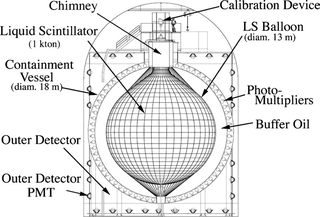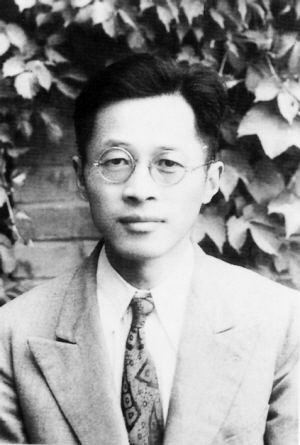Related Research Articles

In nuclear physics, beta decay (β-decay) is a type of radioactive decay in which an atomic nucleus emits a beta particle, transforming into an isobar of that nuclide. For example, beta decay of a neutron transforms it into a proton by the emission of an electron accompanied by an antineutrino; or, conversely a proton is converted into a neutron by the emission of a positron with a neutrino in so-called positron emission. Neither the beta particle nor its associated (anti-)neutrino exist within the nucleus prior to beta decay, but are created in the decay process. By this process, unstable atoms obtain a more stable ratio of protons to neutrons. The probability of a nuclide decaying due to beta and other forms of decay is determined by its nuclear binding energy. The binding energies of all existing nuclides form what is called the nuclear band or valley of stability. For either electron or positron emission to be energetically possible, the energy release or Q value must be positive.

A neutrino is a fermion that interacts only via the weak interaction and gravity. The neutrino is so named because it is electrically neutral and because its rest mass is so small (-ino) that it was long thought to be zero. The rest mass of the neutrino is much smaller than that of the other known elementary particles. The weak force has a very short range, the gravitational interaction is extremely weak due to the very small mass of the neutrino, and neutrinos do not participate in the electromagnetic interaction or the strong interaction. Thus, neutrinos typically pass through normal matter unimpeded and undetected.

Jack Steinberger was a German-born American physicist noted for his work with neutrinos, the subatomic particles considered to be elementary constituents of matter. He was a recipient of the 1988 Nobel Prize in Physics, along with Leon M. Lederman and Melvin Schwartz, for the discovery of the muon neutrino. Through his career as an experimental particle physicist, he held positions at the University of California, Berkeley, Columbia University (1950–68), and the CERN (1968–86). He was also a recipient of the United States National Medal of Science in 1988, and the Matteucci Medal from the Italian Academy of Sciences in 1990.

Raymond Davis Jr. was an American chemist and physicist. He is best known as the leader of the Homestake experiment in the 1960s-1980s, which was the first experiment to detect neutrinos emitted from the Sun; for this he shared the 2002 Nobel Prize in Physics.

In nuclear physics, double beta decay is a type of radioactive decay in which two neutrons are simultaneously transformed into two protons, or vice versa, inside an atomic nucleus. As in single beta decay, this process allows the atom to move closer to the optimal ratio of protons and neutrons. As a result of this transformation, the nucleus emits two detectable beta particles, which are electrons or positrons.

Neutrinoless double beta decay (0νββ) is a commonly proposed and experimentally pursued theoretical radioactive decay process that would prove a Majorana nature of the neutrino particle. To this day, it has not been found.

The Kamioka Liquid Scintillator Antineutrino Detector (KamLAND) is an electron antineutrino detector at the Kamioka Observatory, an underground neutrino detection facility in Hida, Gifu, Japan. The device is situated in a drift mine shaft in the old KamiokaNDE cavity in the Japanese Alps. Although located in the Kamioka Observatory, which is part of the University of Tokyo, this project is conducted by a team at Tohoku University. The site is surrounded by 53 Japanese commercial nuclear reactors. Nuclear reactors produce electron antineutrinos () during the decay of radioactive fission products in the nuclear fuel. Like the intensity of light from a light bulb or a distant star, the isotropically-emitted flux decreases at 1/R2 per increasing distance R from the reactor. The device is sensitive up to an estimated 25% of antineutrinos from nuclear reactors that exceed the threshold energy of 1.8 megaelectronvolts (MeV) and thus produces a signal in the detector.
In spectroscopy, a forbidden mechanism is a spectral line associated with absorption or emission of photons by atomic nuclei, atoms, or molecules which undergo a transition that is not allowed by a particular selection rule but is allowed if the approximation associated with that rule is not made. For example, in a situation where, according to usual approximations, the process cannot happen, but at a higher level of approximation the process is allowed but at a low rate.
The Enriched Xenon Observatory (EXO) is a particle physics experiment searching for neutrinoless double beta decay of xenon-136 at WIPP near Carlsbad, New Mexico, U.S.

Wang Ganchang was a Chinese nuclear physicist. He was one of the founding fathers of Chinese nuclear physics, cosmic rays and particle physics. Wang was also a leader in the fields of detonation physics experiments, anti-electromagnetic pulse technology, nuclear explosion detection, anti-nuclear radiation technology, and laser stimulated nuclear explosion technologies.

Borexino is a deep underground particle physics experiment to study low energy (sub-MeV) solar neutrinos. The detector is the world's most radio-pure liquid scintillator calorimeter and is protected by 3,800 meters of water-equivalent depth. The scintillator is pseudocumene and PPO which is held in place by a thin nylon sphere. It is placed within a stainless steel sphere which holds the photomultiplier tubes (PMTs) used as signal detectors and is shielded by a water tank to protect it against external radiation. Outward pointing PMT's look for any outward facing light flashes to tag incoming cosmic muons that manage to penetrate the overburden of the mountain above. Neutrino energy can be determined through the number of photoelectrons measured in the PMT's. While the position can be determined by extrapolating the difference in arrival times of photons at PMT's throughout the chamber.

Kam-Biu Luk is a professor of physics, with a focus on particle physics, at UC Berkeley and a senior faculty scientist in the Lawrence Berkeley National Laboratory's physics division. Luk has conducted research on neutrino oscillation and CP violation. Luk and his collaborator Yifang Wang were awarded the 2014 Panofsky Prize "for their leadership of the Daya Bay experiment, which produced the first definitive measurement of θ13 angle of the neutrino mixing matrix." His work on neutrino oscillation also received 2016 Breakthrough Prize in Fundamental Physics shared with other teams. He also received a Doctor of Science honoris causa from the Hong Kong University of Science and Technology in 2016. Luk is a fellow of the American Physical Society, and the American Academy of Arts and Sciences.
Herbert Hwa-sen Chen was a theoretical and experimental physicist at the University of California at Irvine known for his contributions in the field of neutrino detection. Chen's work on observations of elastic neutrino-electron scattering provided important experimental support for the electroweak theory of the standard model of particle physics. In 1984 Chen realized that the deuterium of heavy water could be used as a detector that would distinguish the flavors of solar neutrinos. This idea led Chen to develop plans for the Sudbury Neutrino Observatory that would eventually make fundamental measurements demonstrating that neutrinos were particles with mass.
Stuart Jay Freedman was an American physicist, known for his experiment testing Bell's inequality proposed to him by John Clauser at the University of California, Berkeley as well as for his contributions to nuclear and particle physics, particularly weak interaction physics. He was a graduate of Berkeley, receiving a Bachelor of Science in 1965 and his PhD in physics in 1972 under Eugene Commins. While at Berkeley, he worked with fellow graduate student Steven Chu. He was also recipient of 2007 Tom W. Bonner Prize in Nuclear Physics.
Eugene William Beier is an American physicist.

Kevin Insik Hahn is a South Korean physicist who is an expert in the fields of nuclear physics and nuclear astrophysics. Since December 2019, he has been the director of the Center for Exotic Nuclear Studies at the Institute for Basic Science (IBS) in South Korea. He also holds an endowed professorship in the Department of Science Education at Ewha Womans University, where he has worked since 1999. In his research, he has worked on accelerator-based as well as non-accelerator-based experiments. His current research activities involve a number of accelerators around the world, including the RI Beam Factory (RIBF) at RIKEN, Relativistic Heavy Ion Collider (RHIC) at Brookhaven National Laboratory, and the soon-to-open Rare isotope Accelerator complex for ON-line experiment (RAON). During his tenure at Ewha Womans University, he promoted STEM/STEAM education by serving for multiple years as the director of the Advanced STEAM Teacher Education Center. He also wrote several physics textbooks for high school students and undergraduate students.
Karol Sylwester Lang is an experimental particle physicist and the Jane and Roland Blumberg Professor of Physics at the University of Texas at Austin.
Eric B. Norman is an American physicist. He is a professor in the graduate school of the University of California, Berkeley.
Felix Hans Boehm was a Swiss-American experimental physicist, known for his research on weak interactions, parity violation, and neutrino physics.
George Michael Fuller is an American theoretical physicist, known for his research on nuclear astrophysics involving weak interactions, neutrino flavor-mixing, and quark matter, as well as the hypothetical nuclear matter.
References
- ↑ biographical information from American Men and Women of Science, Thomson Gale 2004
- ↑ Elliott, S. R.; Hahn, A. A.; Moe, M. K. (1987). "Direct evidence for two-neutrino double-beta decay in 82Se". Phys. Rev. Lett. 59 (18): 2220–2223. Bibcode:1987PhRvL..59.2020E. doi:10.1103/PhysRevLett.59.2020. PMID 10035397.
- ↑ Browne, Malcolm W. (4 September 1987). "Predicted Decay of Element Seen". NY Times.
- 1 2 2013 Tom W. Bonner Prize in Nuclear Physics Recipient, Michael K. Moe
- ↑ Moe, M. K. (1991). "New approach to the detection of neutrinoless double beta decay". Phys. Rev. C. 44 (3): R931–R934. Bibcode:1991PhRvC..44..931M. doi:10.1103/PhysRevC.44.R931. PMID 9967528.